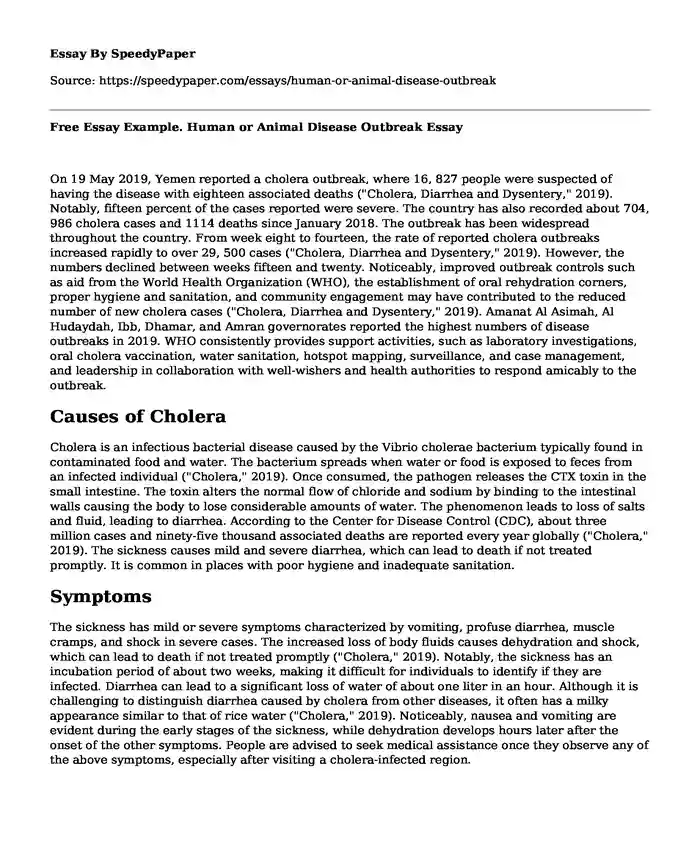
| Type of paper: | Essay |
| Categories: | Biology World Healthcare policy Public health |
| Pages: | 3 |
| Wordcount: | 725 words |
On 19 May 2019, Yemen reported a cholera outbreak, where 16, 827 people were suspected of having the disease with eighteen associated deaths ("Cholera, Diarrhea and Dysentery," 2019). Notably, fifteen percent of the cases reported were severe. The country has also recorded about 704, 986 cholera cases and 1114 deaths since January 2018. The outbreak has been widespread throughout the country. From week eight to fourteen, the rate of reported cholera outbreaks increased rapidly to over 29, 500 cases ("Cholera, Diarrhea and Dysentery," 2019). However, the numbers declined between weeks fifteen and twenty. Noticeably, improved outbreak controls such as aid from the World Health Organization (WHO), the establishment of oral rehydration corners, proper hygiene and sanitation, and community engagement may have contributed to the reduced number of new cholera cases ("Cholera, Diarrhea and Dysentery," 2019). Amanat Al Asimah, Al Hudaydah, Ibb, Dhamar, and Amran governorates reported the highest numbers of disease outbreaks in 2019. WHO consistently provides support activities, such as laboratory investigations, oral cholera vaccination, water sanitation, hotspot mapping, surveillance, and case management, and leadership in collaboration with well-wishers and health authorities to respond amicably to the outbreak.
Causes of Cholera
Cholera is an infectious bacterial disease caused by the Vibrio cholerae bacterium typically found in contaminated food and water. The bacterium spreads when water or food is exposed to feces from an infected individual ("Cholera," 2019). Once consumed, the pathogen releases the CTX toxin in the small intestine. The toxin alters the normal flow of chloride and sodium by binding to the intestinal walls causing the body to lose considerable amounts of water. The phenomenon leads to loss of salts and fluid, leading to diarrhea. According to the Center for Disease Control (CDC), about three million cases and ninety-five thousand associated deaths are reported every year globally ("Cholera," 2019). The sickness causes mild and severe diarrhea, which can lead to death if not treated promptly. It is common in places with poor hygiene and inadequate sanitation.
Symptoms
The sickness has mild or severe symptoms characterized by vomiting, profuse diarrhea, muscle cramps, and shock in severe cases. The increased loss of body fluids causes dehydration and shock, which can lead to death if not treated promptly ("Cholera," 2019). Notably, the sickness has an incubation period of about two weeks, making it difficult for individuals to identify if they are infected. Diarrhea can lead to a significant loss of water of about one liter in an hour. Although it is challenging to distinguish diarrhea caused by cholera from other diseases, it often has a milky appearance similar to that of rice water ("Cholera," 2019). Noticeably, nausea and vomiting are evident during the early stages of the sickness, while dehydration develops hours later after the onset of the other symptoms. People are advised to seek medical assistance once they observe any of the above symptoms, especially after visiting a cholera-infected region.
Cholera in the Environment
The cholera bacterium is naturally found in coastal and swampy waters and travels through its host to other locations. People infected with the bacteria spread it to others through feces. Poor sanitary conditions, eating raw food, consumption of seafood, and reduced stomach acid are the primary risk factors associated with the illness. According to WHO, the deteriorating political crisis in Yemen has contributed significantly to the spread of cholera in the country since 2016 (Sana'a, 2019). The United Nations perceives the phenomenon as the worst humanitarian crisis to have ever been reported since the discovery of cholera in 1949. The nation has been unable to provide an appropriate response to the outbreak due to its crippled health system. The spread has been intensified by the lack of proper sanitation services and safe water (Sana'a, A. (2019). Yemen also has limited water, sanitation, and hygiene infrastructure (WaSH) since most of them have been destroyed by bombings. As a result, many nations, including the United States, Japan, United Arab Emirates, and Saudi Arabia, have been at the forefront to provide humanitarian aid to the citizens. Vaccination activities are also underway to minimize the spread of the disease.
References
Cholera- Vibrio cholerae infection. (2019). Center for Disease Control and Prevention. Retrieved from https://www.cdc.gov/cholera/general/index.html
Cholera, Diarrhea and Dysentery Update (15): Asia (Yemen). Archive Number: 20190530.6493539. Retrieved from https://www.promedmail.org/
Sana'a, A. (2019). Donations from Saudi Arabia and United Arab Emirates provide access to health care for millions in Yemen. World Health Organization. Retrieved from http://www.emro.who.int/yem/yemen-news/donations-from-ksa-and-uae-provide-access-to-healthcare-for-millions-of-people-in-yemen.html
Cite this page
Free Essay Example. Human or Animal Disease Outbreak. (2023, Jan 22). Retrieved from https://speedypaper.net/essays/human-or-animal-disease-outbreak
Request Removal
If you are the original author of this essay and no longer wish to have it published on the SpeedyPaper website, please click below to request its removal:
- Essay Sample Dedicated to Lalla Essaydi, A Female Artist
- Does Alibaba Make a Successful Entry into the United States Market? Free Essay Answers
- Negative Effects of Technology on Interpersonal Communication, Essay Sample
- Essay Sample on the Nature of the Human Race
- Essay Example about the Development of Domestic Economic and Foreign Policy
- Essay Sample. Using Health Information Exchange to Improve Public Health
- Nurses: The Power of Political Advocacy in Healthcare - Essay Sample
Popular categories




